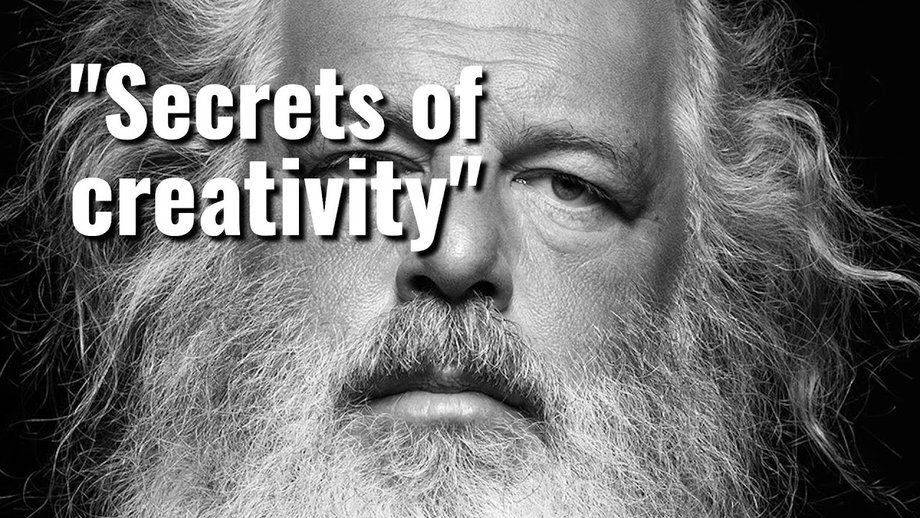Rick Rubin Unlocks the Secrets of How to Develop Creativity

Rick Rubin’s book, ‘The Creative Act: A Way of Being’, offers practical tools and insights to unlock the secrets of creativity. It provides transformative knowledge in the realm of art and beyond. This makes it a must-read for anyone seeking to enhance their creative abilities.
Key Takeaways
- Rick Rubin’s expertise in the creative process extends beyond music and encompasses various domains such as writing, film, and science.
- He shares practical tools for accessing the creative process and offers wisdom applicable to multiple domains, shedding light on fundamental features of being human.
- The conversation with Rick Rubin will be recorded and posted as a clip, and he generously offers to answer questions about creativity from the audience.
- The sponsors of the podcast include Maui Nui, Thesis, and WHOOP, emphasizing the importance of quality protein, customized nootropic formulas, and tracking daily activity and sleep for better performance, respectively.
Rick Rubin’s Creative Expertise
Rick Rubin’s creative expertise is renowned for his ability to extract the best from artists across different genres, making him an enigma in the music industry and beyond. His unique talent lies in capturing creative sensations, allowing artists to tap into their deepest wells of inspiration and produce their most authentic work.
However, even with his exceptional skills, Rubin acknowledges that there are limitations in the creative process. He understands that creativity is a delicate balance between rules and artistic freedom, and that too many limitations can stifle the creative flow.
Rubin’s approach is to provide artists with a space that encourages exploration and experimentation, while also providing guidance and structure when needed. Through his understanding of these limitations, Rubin has become a master at unlocking the full potential of artists and helping them create their most impactful and meaningful work.
Exploring Creativity Across Different Domains
Exploring creativity across different domains reveals the diverse ways in which individuals can harness their creative potential beyond the boundaries of a specific discipline. Rick Rubin, known for his expertise in the creative process, extends his exploration of creativity beyond music and delves into various domains such as writing, film, and even science. By doing so, he sheds light on the scientific aspects of creativity and offers practical tools for accessing the creative process.
To better understand this concept, we can examine the following table:
| Domain | Description | Example |
|---|---|---|
| Writing | Expressing ideas and emotions through written words | Writing a novel |
| Film | Creating visual narratives through moving images | Directing a film |
| Science | Discovering new knowledge through systematic inquiry | Conducting scientific experiments |
Through his exploration of creativity in these different domains, Rubin demonstrates how creativity is not limited to a specific field. Instead, it can be applied and cultivated across various disciplines, allowing individuals to tap into their creative potential in diverse ways. By understanding the scientific aspects of creativity, individuals can unlock their own creative process and apply it to different areas of their lives.
The Themes Discussed in the Conversation
The conversation with Rick Rubin delves into a range of themes related to the creative process, shedding light on fundamental aspects of creativity and its practical applications in everyday life.
One of the themes explored is the interaction between the subconscious and conscious mind in the creative process. Rubin discusses how the subconscious mind plays a crucial role in generating ideas and insights, while the conscious mind helps to refine and execute those ideas.
Another theme discussed is the influence of nature on creativity. Rubin emphasizes the importance of connecting with nature as a way to stimulate creativity and find inspiration. He suggests that spending time in natural environments can help to clear the mind and open up new possibilities for creative thinking.
Rick Rubin’s Generosity in Sharing Knowledge
Rick Rubin’s generosity is evident in his willingness to share his knowledge of the creative process with others. He understands the importance of capturing creativity and nurturing children’s creativity, and he actively encourages people to ask questions about these topics.
In his conversations, Rubin emphasizes the value of sharing zero-cost information about science and tools, highlighting his commitment to serving others. By offering to answer questions and recording the conversations for others to benefit from, Rubin goes above and beyond to ensure that his knowledge reaches as many people as possible.
His generosity extends beyond music, as he explores creativity in various domains and provides practical tools for accessing the creative process. Through his actions, Rubin demonstrates his dedication to helping others unlock their creativity and tap into their true potential.
Sponsors of the Podcast
The podcast is proudly sponsored by a variety of companies, each offering unique products and services related to health, nutrition, and performance enhancement.
One of the sponsors is Maui Nui, which provides nutrient-dense and delicious red meat. They emphasize the importance of quality protein for tissue repair, which is essential for optimal performance. Listeners can enjoy a 20% discount on their first order at mauinuivenison.com/huberman.
Another sponsor is Thesis, a company that customizes nootropic formulas tailored to unique needs. They offer a 10% discount on the first box with the code Huberman at takethesis.com/huberman.
Lastly, WHOOP, a company that tracks daily activity and sleep for better performance, sponsors the podcast. They work towards unlocking human performance and Andrew Huberman is a member of their Scientific Advisory Council.
Capturing the Elusive Nature of Creativity
Capturing the elusive nature of creativity requires an exploration of its enigmatic origins and the complex interplay between conscious and subconscious processes. Rick Rubin, with his extensive experience in working with artists across various domains, offers valuable insights into unlocking inspiration. In his book ‘The Creative Act: A Way of Being’, he delves into the practical tools for accessing the creative process. To engage the audience, let’s explore the multifaceted aspects of capturing creativity through a table:
| Subtopic | Description | Key Takeaway |
|---|---|---|
| Definition of Creativity | Understanding what creativity truly means and how it manifests | Creativity encompasses unique expressions of ideas and solutions |
| Origins of Creativity | Uncovering the sources and inspirations that spark creativity | Creativity can stem from personal experiences, observations, and exposure to diverse influences |
| Conscious vs Subconscious | Exploring the relationship between conscious thought and the subconscious mind in the creative process | The subconscious mind plays a vital role in generating innovative ideas and insights |
| Techniques for Unlocking | Discovering practical methods and approaches to tap into one’s creative potential | Embracing curiosity, embracing failure, and creating an environment conducive to creativity |
| Fostering Creative Flow | Understanding the conditions and mindset that facilitate the flow state, where creativity flourishes | Removing distractions, setting clear goals, and cultivating an open and receptive mindset |
Language Limitations in Discussing Creativity
Exploring the intricacies of discussing creativity, one encounters the challenge of language limitations in capturing the essence of this elusive and multifaceted concept. Language barriers can hinder the expression of creative ideas and limit our ability to convey the richness and depth of creative expression.
Creativity is a deeply personal and subjective experience, making it difficult to articulate with precision and clarity. The nuances and intricacies of creative thought and inspiration often defy conventional language, relying instead on metaphor, symbolism, and non-verbal forms of communication.
Moreover, creative expression transcends linguistic boundaries, as it can be experienced and appreciated by individuals from different cultures and backgrounds. Despite these limitations, our pursuit of understanding creativity and its transformative power drives us to explore alternative means of communication, allowing us to connect and inspire others through our artistic endeavors.
Nurturing Children’s Access to Creativity
Nurturing children’s access to creativity involves cultivating an environment that encourages exploration, imagination, and self-expression. In children’s education, fostering creativity is essential as it enhances their cognitive, emotional, and social development.
Providing opportunities for children to engage in creative activities such as art, music, storytelling, and play allows them to express themselves freely and develop their unique talents and abilities. A supportive and encouraging atmosphere, where mistakes are seen as learning opportunities and individuality is celebrated, nurtures children’s creativity.
Teachers and parents play a crucial role in fostering creativity by providing open-ended tasks, encouraging curiosity, and valuing children’s ideas and perspectives. By fostering creativity in children, we empower them to think critically, solve problems creatively, and become innovative thinkers, preparing them for success in an ever-changing world.
The Body as a Source of Creative Inspiration
Children’s access to creativity can be further enhanced by recognizing the body as a profound source of inspiration and harnessing its innate ability to ignite the creative process.
The role of intuition in creativity becomes evident when we pay attention to the sensations and impulses that arise within us. Our bodies are constantly sending signals and messages that can guide our creative endeavors.
By practicing mindfulness and being fully present in our bodies, we can tap into a deeper level of awareness and connect with our intuition. This connection allows us to access new ideas, perspectives, and solutions that may not have been apparent before.
Mindfulness also helps us to quiet the noise of our busy minds and create the space needed for creativity to flourish. By tuning into our bodies and practicing mindfulness, we can unlock the wellspring of creative inspiration that resides within us.
Balancing Rules and Artistic Freedom
Finding the right balance between adhering to rules and embracing artistic freedom is a crucial aspect of navigating the creative process. Balancing structure and expression allows artists to find their unique voice while still working within certain parameters.
Rules and guidelines provide a framework and help establish a sense of coherence and clarity in creative work. They provide a foundation upon which artists can build and experiment. However, too much adherence to rules can stifle creativity and limit the possibilities for innovation.
On the other hand, complete artistic freedom without any structure can result in chaos and lack of focus. Finding creative boundaries is about understanding the rules and then pushing the boundaries to explore new possibilities, while still maintaining a sense of structure and intention in the creative process.
The Power of Artists to Challenge Beliefs
Artists possess a profound ability to challenge and question long-held beliefs, provoking thought and inspiring change through their creative expressions.
Through artistic rebellion and the challenging of societal norms, artists have the power to disrupt the status quo and spark meaningful conversations. By presenting alternative perspectives and pushing boundaries, they encourage others to question their own beliefs and consider new possibilities.
Artistic rebellion can take various forms, such as visual art, music, literature, or performance art. These creative expressions serve as a platform for artists to challenge established ideologies, social norms, and cultural expectations.
Frequently Asked Questions
How Can Rick Rubin’s Expertise in the Creative Process Be Applied to Domains Other Than Music?
Applying creativity in different fields involves expanding the concept beyond music. Rick Rubin’s expertise in the creative process translates to various domains, offering practical tools and insights. His ability to extract the best from artists is applicable across disciplines.
Practical techniques for accessing the creative process include cultivating a creative mindset, embracing curiosity, engaging in mindfulness practices, seeking inspiration from diverse sources, and experimenting with different methods of expression.
How Does Rick Rubin Define and Explain the Origins of Creativity?
Rick Rubin’s insights on the origins of creativity offer a deep dive into the creative process and its connection to the subconscious mind. He defines creativity as the ability to access and channel subconscious information into conscious expression.
What Scientific Aspects of the Creative Process Does Rick Rubin Explore in His Book?
The book explores the scientific aspects of the creative process, delving into topics such as the interaction between subconscious and conscious mind, the influence of nature on creativity, and practical applications of creativity in everyday life.
How Can Creativity Be Practically Applied in Everyday Life According to Rick Rubin?
Practical applications of creativity in everyday life involve unlocking creativity in different domains. Rick Rubin explores how creativity can be practically applied, offering wisdom and tools applicable to multiple areas such as writing, film, and science.









